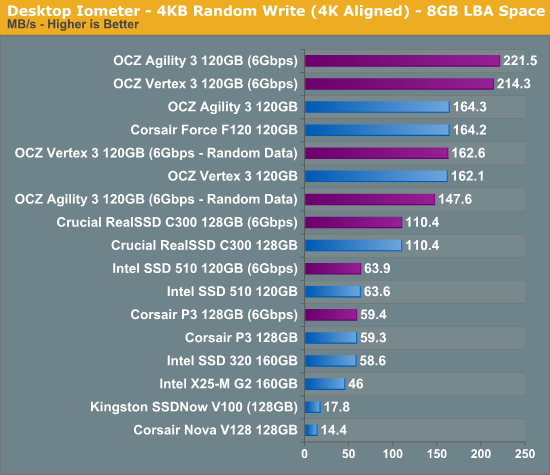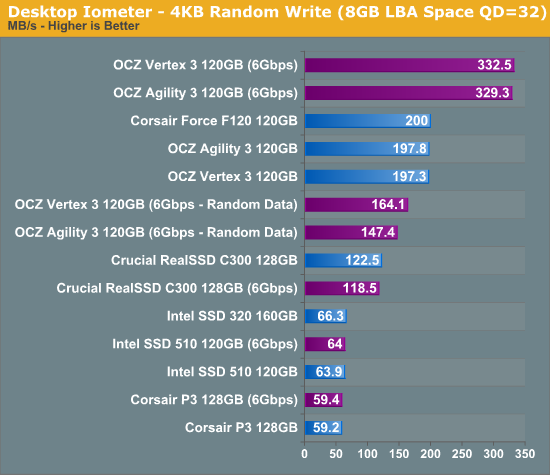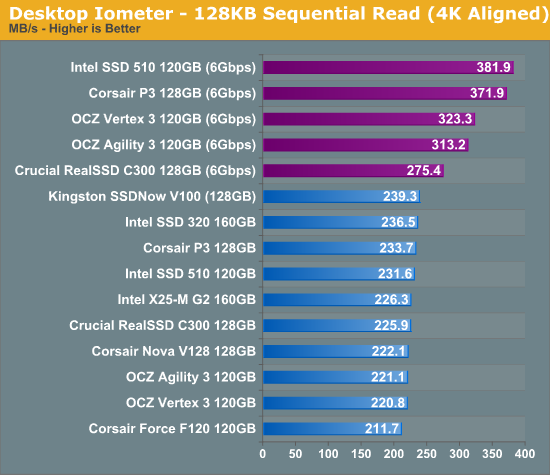The 2011 Mid-Range SSD Roundup: 120GB Agility 3, Intel 510 and More Compared
by Anand Lal Shimpi on June 7, 2011 12:52 PM ESTRandom Read/Write Speed
The four corners of SSD performance are as follows: random read, random write, sequential read and sequential write speed. Random accesses are generally small in size, while sequential accesses tend to be larger and thus we have the four Iometer tests we use in all of our reviews.
Our first test writes 4KB in a completely random pattern over an 8GB space of the drive to simulate the sort of random access that you'd see on an OS drive (even this is more stressful than a normal desktop user would see). I perform three concurrent IOs and run the test for 3 minutes. The results reported are in average MB/s over the entire time. We use both standard pseudo randomly generated data for each write as well as fully random data to show you both the maximum and minimum performance offered by SandForce based drives in these tests. The average performance of SF drives will likely be somewhere in between the two values for each drive you see in the graphs. For an understanding of why this matters, read our original SandForce article.

At worst, SandForce's small file random write performance is equal to its closest competitors, but at best it is significantly greater. Both the Vertex 3 and Agility 3 take the cake here. The Marvell based solutions are significantly slower, however we'll see if that matters in the real world tests.
Many of you have asked for random write performance at higher queue depths. What I have below is our 4KB random write test performed at a queue depth of 32 instead of 3. While the vast majority of desktop usage models experience queue depths of 0 - 5, higher depths are possible in heavy I/O (and multi-user) workloads:

At higher queue depths the advantage just grows for the SF-2281 drives.

Crucial optimized very heavily for random read performance, and to this day nothing (even the replacement m4/C400) can outperform the C300 in our small file random read test. Intel's SSD 510 is the next fastest 6Gbps drive we've got here, followed by the P3 and eventually the Vertex 3/Agility 3.
Sequential Read/Write Speed
To measure sequential performance I ran a 1 minute long 128KB sequential test over the entire span of the drive at a queue depth of 1. The results reported are in average MB/s over the entire test length.

To post high sequential read speeds you need to have a 6Gbps interface these days. Armed with one the Intel SSD 510 and Corsair P3 both post the highest scores here. Even the Vertex 3/Agility 3 are a bit behind the two Marvell drives.

Sequential write performance is another story entirely. With highly compressible data the Vertex 3 is untouched and even in the worst case it's still among the fastest drives. I'll chalk this one up as a win for OCZ, however the rest of the competitors do well here.










68 Comments
View All Comments
Oxford Guy - Thursday, June 9, 2011 - link
And so the 240 GB Vertex 2 would be nice to see in a review -- for perspective.jjj - Tuesday, June 7, 2011 - link
without the M4 and the MAX IOPS the comparisson is pointelss since those 2 models are the most interesting on the market atm at 120GB.dcuccia1 - Tuesday, June 7, 2011 - link
This is fantastic, thanks for the roundup. I'd love to see the same analysis at the low-end. When I build my or mom a PC with a 64GB SSD drive, I have no firm grasp on which generation of drives have the best value for a mom-style workload (word processing, music, videos, etc).SmCaudata - Tuesday, June 7, 2011 - link
Anything you can find.I have a first gen vertex 60gb that I got for $89 or something on sale before the Vertex2 drives came out. Even coming from a 1gb samsung F3 it was night and day. Outlook opens instantly and that is by far the most data intensive of the general use/productivity programs. I'm guessing music and videos will be on a separate drive anyway due to size and they play back at a fixed speed regardless so a spindle drive is just as fast for them.
So again, in summary... anything from a reputable vendor is likely going to be night and day. If you can pick up an Intel for reliability that would be a good way to go. There are some firmware issues with the c300 drives that have the potential to make them really slow, but I'm not familiar with them so I cannot speak to the specifics.
dcuccia - Wednesday, June 8, 2011 - link
Thanks, good points all around. Still, would be cool to see which drives gave a good bang for the buck for light workload systems. But you're right, at the right price it would be hard to go wrong with an old Vertex or Intel.Mr Perfect - Tuesday, June 7, 2011 - link
I'm also interested in how 64GB drives would scale, but only because they are the largest drives Intel will let you use for SSD caching. That would be completely different benchmark runs though...tecsi - Friday, July 8, 2011 - link
Yes, I have exactly the same question. What about boot/app desktop SSDs in the 40-100GB range (<$100)?Quizzical - Tuesday, June 7, 2011 - link
Are you sure that the Crucial RealSSD C300 only has 111.8 GB of usable capacity? Last July, you said that exactly the same SSD had 119.2 GB. I have the "64 GB" version of the same drive, and Windows reads it as 59.5 GB of usable capacity, so I'd expect the "128 GB" version to be around 119 GB.I don't have one, but Legit Reviews also shows the Corsair Performance 3 as having 119 GB of usable capacity, not 111.8 GB. In the past, Corsair has been inclined to do the usual hard drive manufacturer shenanigans of claiming 1 billion bytes as 1 GB, but not going beyond that and listing the total NAND flash. See the F115, which gives you about 115 billion bytes of capacity, but isn't marketed as a 128 GB drive, in spite of 128 GB of NAND flash.
Anand Lal Shimpi - Tuesday, June 7, 2011 - link
You're very correct, fixed :)Tommyv2 - Tuesday, June 7, 2011 - link
Should've waiting until you had the 120GB m4 and the 120GB Max IOPs units for review, especially with some other sites showing that the 120GB m4 actually beats out the 240GB unit in some benchmarks! Those are the two I'm most interested in, and yet there are too few reviews out there for them...